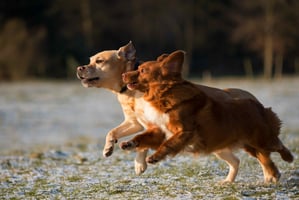Training a Cocker Spaniel can be a rewarding experience for both you and your pet. This guide will...
Curly-Coated Retriever Training: Everything You Need to Know
Training a Curly-Coated Retriever can be a rewarding experience that strengthens the bond between you and your pet. But as with any breed, there are some unique considerations to keep in mind. In this article, we’ll cover the basics of Curly-Coated Retriever training, from housebreaking to obedience and more.
Understanding the Curly-Coated Retriever Temperament
The Curly-Coated Retriever is a highly intelligent, active breed that loves to explore and play. They have an independent streak and need a consistent, firm hand in training to ensure they don’t become too unruly. They are also very sensitive and can become easily stressed, so it’s important to ensure that training is done in a positive, reward-based way.
Curly-Coated Retrievers are highly trainable and eager to please, and with the right approach they can learn a range of commands and tricks.
Housebreaking
Housebreaking a Curly-Coated Retriever is relatively straightforward, but it’s important to be consistent. Start by establishing a regular potty schedule and sticking to it. Take your pup outside at the same times every day and reward them with a treat or a toy when they go in the right place.
It’s also important to be aware of your pup’s signs that they need to go. If you notice them sniffing around or pacing, take them outside immediately. If they do have an accident, don’t scold them – simply clean it up and move on.
Obedience Training
Obedience training is a great way to build a strong bond with your Curly-Coated Retriever and ensure they are well-behaved in all situations. Start with the basics, such as sit, stay, and come, and use positive reinforcement such as treats or praise when your pup does the right thing.
It’s also important to set boundaries and establish yourself as the alpha. For example, if your pup is jumping on the furniture, don’t let them. Instead, redirect their attention to an appropriate activity and reward them when they obey.
Socialisation
Socialisation is an important part of any training plan. It’s important to ensure your pup is comfortable around people and other animals so they can be confident in all situations. Take your pup to the park or a dog-friendly cafe and let them interact with other dogs and people.
It’s also important to expose them to different sounds, sights, and smells. Take them for a walk in a busy area or take them to a pet store. Reward them with treats or praise when they show positive behaviour.
Exercise and Mental Stimulation
Curly-Coated Retrievers are active dogs that need plenty of exercise and mental stimulation. Take them for long walks and let them explore. They also love to swim and play fetch. You can also use puzzle toys to keep their minds active and engaged.
It’s also important to vary your training routine to keep your pup interested and engaged. Try new activities such as agility or tracking, or play a game of hide-and-seek. This will help keep them mentally and physically stimulated.
Things to Avoid
When training your Curly-Coated Retriever, it’s important to avoid certain techniques. Physical punishment, such as hitting or yelling, is never an appropriate way to train a dog. It can lead to fear and aggression, and it won’t help your pup learn.
It’s also important to avoid using food as the only reward. Use verbal praise or toys as well to keep your pup motivated and engaged.
Conclusion
Training a Curly-Coated Retriever can be a rewarding experience for both you and your pup. It’s important to understand the breed’s temperament, use positive reinforcement, and provide plenty of exercise and mental stimulation. With the right approach, your pup will be well-behaved and obedient in no time.
- Start with housebreaking and establish a regular potty schedule
- Obedience training should use positive reinforcement and set boundaries
- Socialisation is key to ensuring your pup is comfortable in all situations
- Provide plenty of exercise and mental stimulation to keep your pup engaged
- Avoid physical punishment and using food as the only reward



